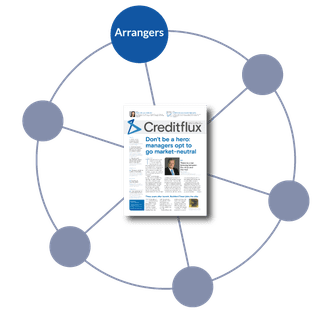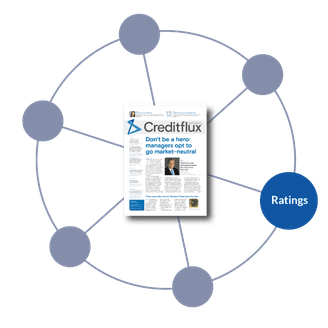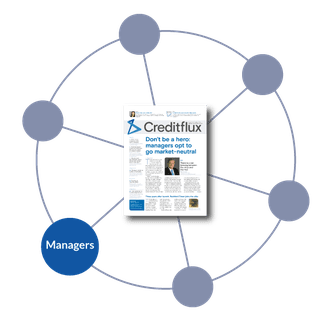

March 2021 | Issue 232
Analysis
CLOs
Waiting for afters

Charlie Dinning
Data journalist
Day one arb remains important, but last year there were opportunities aplenty in the secondary market, which put the onus on printing CLOs and waiting for the day after non-call periods expired
The coronavirus pandemic had the potential to shut down the CLO market for years if managers and investors could not make deal economics work. After all, one of the most popular CLO conference sound bites is that “the arb remains challenging”.
US CLOs that went effective in the first quarter of 2020 had an average cost of debt of 191 basis points above Libor and 156bp of spread arbitrage. That figure was lower than Q4 2019 when five-year US CLOs had a 162bp buffer. In Europe arbitrage improved, going from 184bp in late in 2019 to 189bp in Q1 2020 (when cost of debt was 196bp).
In March 2020, when the coronavirus pandemic hit financial markets, CLO liability spreads leapt to historic wides (CLO triple As went to 400bp in the secondary market for a brief period), assets were downgraded at an earth-shattering pace, a large chunk of CLOs failed overcollateralisation (OC) tests, and CLO warehouses threatened to go underwater as the market teetered.
Yet the primary US CLO market was only out of action for 21 days. Those with conviction were able to see past the fact that liability spreads were wide.
US CLO day one arbitrage: WAS (%) vs funding cost (%)




Short non-calls after the shutdown
The first four US CLO new issues to price after the pause were all print-and-sprint opportunistic transactions with reinvestment periods ranging from Blackstone Credit’s static CLO, Stratus 2020-1 to a three-year reinvestment period CLO, Guggenheim 2020-1. The call-locks for all four CLOs were set at one year.
These short profile CLOs were in vogue as market participants were not willing to lock in five-year reinvestment periods when spreads had shifted so wide.
Dan Ko, portfolio manager at Eagle Point Credit Management, says the CLO market learned about the value of shorter profiles following the 2016 oil and gas crisis. “The shorter call locks would have lined up well with the surge in loan repricings during 2017 and 2018. But by being in the non-call for two years, CLO equity was hit by the 2017 and 2018 loan repricing wave, and the market was unable to commensurately tighten the liabilities.”
156bp
Average day-one arb for US CLOs going effective in Q1 2020
Despite the CLO market opting for shorter reinvestment periods and call-locks to keep funding costs down, the average day-one arbitrage cratered in both markets. New issue US CLOs that went effective in Q2 last year had an average cost of debt of 216bp over Libor and an average day-one arbitrage of 132bp: a 24bp drop from Q1.
In Europe, day-one arbitrage on average fell to 166bp over Euribor for deals that went effective in Q2, a 23bp drop from Q1. But it was European new issues that went effective in Q3 where the real pain was felt. European CLO funding costs jumped to 236bp on average and WAS did not bounce with US spreads, causing day-one arbitrage to slump to a measly 141bp.
132bp
Average day-one arb for US CLOs going effective in Q2 2020
The one-year call-lock on covid-era CLO new issues was the “saving grace for CLO equity”, according to one CLO manager, as it means these CLOs will be refinanced this year. In this sense, the day-one arbitrage of new issue CLOs that priced amid the increased volatility was less important than previous years, according to market sources.
Eddie O’Neill, head of European leveraged credit at KKR, which priced the last pre-covid new issue European CLO in 2020, admits his firm were lucky with timing as “one week later we would not have been able to price Avoca XXI at these levels”. Once Avoca XXI had priced, “the CLO market effectively shut down and the notion of day-one arbitrage went out of the window... as there was not a theoretical arbitrage that worked”.

“The CLO market learned about the value of shorter profiles following the 2016 oil and gas crisis”
Dan Ko, Portfolio manager | Eagle Point Credit Management
KKR priced an opportunistic print and sprint deal in April, while most CLOs that priced in Europe during the peak of the volatility were vehicles dealing with mark-to-market risk on underwater warehouses.
During this period CLO managers were able to source relatively cheap loans in the secondary market which rallied and increased CLO net asset values (NAV). New issue CLOs that priced during the heightened uncertainty had weighted average portfolio prices in the mid-90s of par, compared to the high 99s pre-covid, according to market sources.
The S&P/LSTA US and European loan market indices rose from below 80% in late March to 96 and 97.5, respectively, by the year end, meaning CLO equity NAV had realised the desired pull-to-par effect. In this sense, CLO deal-making became more about principle than interest.

* Deals with less than 6 turns of leverage ** taken over by CIFC in Dec-20 and renamed CIFC Falcon 2020
First Eagle was first back to five years
CLO liabilities also tightened by the end of 2020, so five-year reinvestment period CLOs returned by September. First Eagle was the first manager to broach five years with Wind River 2020-1 and it was rewarded for its pluck as the CLO registered day-one arbitrage of 254bp — the best figure for any US CLO that went effective in 2020.
Wind River 2020-1 was part of an emerging trend as arbitrage recovered significantly in Q4. US CLOs that went effective in that period last year had an average day-one arbitrage of 170bp, the best for any quarter in 2020, as average funding costs fell to 205bp and WAS rose to 375bp, on average.
European CLO day one arbitrage: WAS (%) vs funding cost (%)





* Deals with less than 6 turns of leverage
European day-one arbitrage was 166bp on average in Q4. This was second only to deals that went effective in Q1 as average WAS rose to its highest level of 2020 at 380bp, and funding costs tightened from the highs of Q3 to average 214bp.
Carlyle Euro 2020-1 holds the distinction of having the highest day-one arbitrage of any European CLO that went effective last year. It was priced at the end of February as the manager locked in cheap debt before volatility hit. It had a day-one WAS of 4.01% and a day-one arbitrage of 230bp.

“A week later we would not have been able to price”
Eddie O’Neill, Co-portfolio manager | KKR
The CLO market has shifted between extremes in the past few months — from the depths of the covid crisis in late March 2020 toward historic tights by early 2021.
On last month’s Creditflux CLO webinar, Amit Roy, head of US new issue CLOs at Goldman Sachs, said equity investors were taking a long-term view of CLO economics: wide liability CLOs from 2020 were strong refi candidates this year and the ultra-tight CLOs of 2021 had locked in cheap liabilities for the long haul.
141bp
Average day-one arb for Euro CLOs going effective in Q3 2020
Methodology

- Multiple of money was calculated by dividing aggregate equity payments to date by the par size of the subordinated notes.
- Arbitrage was calculated based on the difference between a CLO’s cost of financing and asset-weighted average spread. Weighted average spread was taken from the effective date report, or the nearest available trustee report to the CLO’s effective date.
- For funding costs, fixed rated tranches were converted to floating rates based on floating rate pari passu tranches. For non-pari passu tranches, the Libor rate when the deal went effective was taken away from the tranche’s fixed rate.
- Data was sourced from CLO-i and Moody’s Analytics and includes only US and European BSL CLOs that went effective in 2020 with reinvestment periods of at least one year. Triple C-flex CLOs were excluded.

Global credit funds & CLO's
March 2021
| Issue 232Published in London & New York.
Copyright Creditflux. All rights reserved. Check our Privacy Policy and our Terms of Use.



























